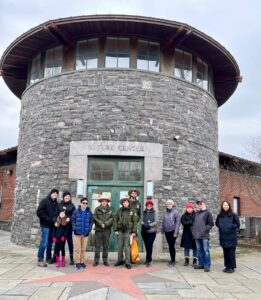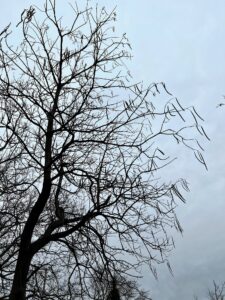Visitors who came to Marine Park’s salt marsh for a Winter Tree and Plant ID Hike event on Sunday, January 29th were pleasantly surprised by their park ranger guides as they were taken off the beaten path and through the “unofficial trail” of the maritime forest.
.
Urban Park Rangers Chow, Miranda-Diaz and Evans, and their hiking group, in front of the Salt Marsh Nature Center.The group met outside the Salt Marsh Nature Center at Avenue U and East 33rd Street with Urban Park Rangers Evans, Miranda-Diaz and Chow who provided guides and information about how to identify trees and plants in the wintertime by looking at the bark, twigs, buds, seeds, fruits, fallen leaves and arrangement of the branches.
“We’re going to explore a maritime forest, one of the few in the city; the other one is in Staten Island,” Miranda-Diaz said of the “weekend adventure” to look at trees native to low-lying swamp and marsh areas.
The hikers entered the gravel trail and stopped often as the rangers took turns identifying the trees and plants they saw along the way.They saw many varieties of oak trees – pin, red, black, swamp white, blackjack and more. Also plentiful was the London planetree with its multicolored bark. It is a cross between an Oriental plane and American sycamore tree and is among the most common of street trees in New York City.
Also of interest was the juniper tree, a conifer whose berries are made into a derivative of gin and provide food for birds in the winter. In addition, there were honey and black locust trees with their deeply furrowed, diamond-shaped bark and hanging seed pods; dawn redwood; black cherry; ailanthus, a host tree of the notorious lanternfly; and lots of pines.

Along the salt marsh trail, the group made a turn onto a narrow meandering dirt path and started walking single file over grass and branch-covered areas as they entered the older and wilder section of the maritime forest.
Large dead fallen trees lay on top of each other on one side. On the other side, glimpses of the Marine Park Golf Course could be seen bordering the outskirts of the path.
The rangers pointed out the invasive and native plants like mugwort; the Japanese knotweed, which is similar to bamboo; sumac, whose berries are good for birds and also for making into a tea or lemonade; and red holly whose lower branches are spiky so deer won’t eat them.
The group also learned how to identify the white pine and was told that the needles can make a tea that is chock-full of Vitamin C; a small handful was said to have more vitamin C than a whole orange.Also in abundance were the Japanese mulberry, whose fruits can be combined with sugar and pectin to create a jam.
The park rangers helped the group to open their eyes to the winter wonderland before them as they became educated about the rich and varied environment located within the park.
“The ecology is really diverse,” Miranda-Diaz said. “Marshlands are our most productive ecosystems out of all our ecosystems.”
Along the way, they pointed out a praying mantis egg sack, a paper hornet nest, a leafy squirrel nest, a natural planting area that experienced a fire over the summer and other interesting sights.
As they exited the trail near the Lenape Playground at East 38th Street and Avenue U, they saw some wild onions growing at the base of an oak tree and a maple tree with holes all across its trunk made by a sapsucker bird.
Other wonders to see were a big catalpa tree, which has long, thin seed pods; the sweet gum tree that has a sap that can be chewed; and the tulip poplar. Then came a really old cherry blossom tree with its thick and gnarly trunk that was likely to be over 100 years old.
But the best came last when a red-tailed hawk was spotted eating its prey high up on the branches of the last tree, the perfect ending to an enjoyable and educational hike through the salt marsh and its maritime forest






